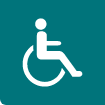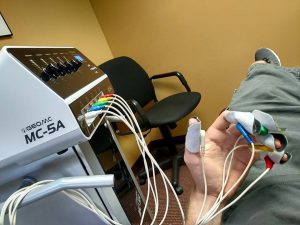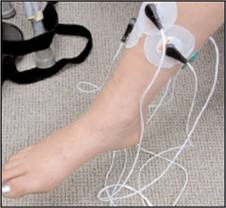We use cookies to improve your experience. By accepting you agree to our cookie policy

When I introduced Calmare Therapy in 2011, the CRPS community was one of the first to discover us. The patients we treated arrived from around the country–not to have scrambler therapy specifically–but to try a new, non-invasive, treatment to potentially lessen their CRPS pain and physical symptoms. Needless to say, the pain medications, implanted devices and invasive treatments they had tried were not successful.
 For about 75 percent of the patients who came for scrambler therapy, some in wheelchairs and others forced to leave school, quit their jobs, move to the sidelines of life, the Calmare treatments were successful and their lives were renewed. We were overjoyed by this success rate (and a little surprised).
For about 75 percent of the patients who came for scrambler therapy, some in wheelchairs and others forced to leave school, quit their jobs, move to the sidelines of life, the Calmare treatments were successful and their lives were renewed. We were overjoyed by this success rate (and a little surprised).
How we measured this success rate:
Since 2011, we have treated several hundred patients, the majority of whom were CRPS patients traveling to us from as far away as South Africa, Australia, Africa and the UK.
In recent years, we have seen a marked increase in pediatric patients battling CRPS.
Make no mistake–even as a healthcare professional–it’s particularly painful to watch parents deal with a child debilitated by neuropathy. The last thing any parent or caregiver wants to do is subject their child to painful therapy or watch them suffer day after day. Additionally, no parent we’ve ever met wants to give their child narcotics to combat pain, even for the short-term. But, if your child is suffering, you’ll do just about anything to help them feel better.
So when children and teens experience pain resolution after 10 painless scrambler therapy treatments, it is beyond satisfying.
 Children or teenagers are comfortably connected to the Calmare Pain Therapy Treatment® device via small electrodes (similar to those used in EKG and other medical procedures) placed on the patient’s skin at the pain site/s.
Children or teenagers are comfortably connected to the Calmare Pain Therapy Treatment® device via small electrodes (similar to those used in EKG and other medical procedures) placed on the patient’s skin at the pain site/s.
The device then sends a very low current of electrical stimulation through the skin and nerve fibers, which carries a “no-pain” signal to the brain, essentially overriding the previous pain signal.
We recommend the child have books, magazines or handheld entertainment to help pass the time during the 35-minute daily treatments.
In some cases, pain relief has been reported after the first treatment, but each child’s case is unique.
Scrambler therapy treatments are performed over a two-week period, with the goal of the patient’s pain steadily decreasing, eliminating the need for wheelchairs, canes or any mobility support devices.
After ample rest and care is taken not to “do too much too soon,” pediatric patients soon return to school and normal daily activities.
Since the Calmare MC-5A device is FDA-cleared, has no side effects and cannot worsen an existing condition, the overall risk factor is very low. There are no drugs, injections or surgery connected with scrambler therapy.
During the 10-treatment course of therapy, most children with diagnosed CRPS will identify a reduction in pain by the fifth treatment, some as soon as the first treatment.
The youngest patient we have treated was 11-years-old.
Regardless of age, patients who arrived at our clinic had “tried it all and done it all” in regard to taking back control from CRPS. Not surprisingly, many were initially skeptical (and who could blame them?)
Keep in mind, we have also helped adults, parents, and grandparents, most suffering from chronic nerve pain levels from 8-10 every day. And after 10 daily treatment sessions lasting about 35-minutes each, more than eight in 10 patients achieved a pain-free state or a reduction in pain to a degree that enabled them to finally get back in the game of life.
Have you read the other Calmare Therapy (Scrambler Therapy) for CRPS articles by Dr Michael Cooney? Why not take a look at the other CRPS articles?
 Dr. Michael Cooney is one of seven USA certified providers of Calmare scrambler therapy. He specializes in treating patients battling severe neuropathy as a result of CRPS / RSD, fibromyalgia, diabetes, shingles, post-surgical pain and pain after chemotherapy.
Dr. Michael Cooney is one of seven USA certified providers of Calmare scrambler therapy. He specializes in treating patients battling severe neuropathy as a result of CRPS / RSD, fibromyalgia, diabetes, shingles, post-surgical pain and pain after chemotherapy.
To contact Dr. Cooney at his clinic in New Jersey just outside New York City, email him at CalmareNJ@gmail.com or call 001-201-933-4440. To learn more, visit www.calmaretherapynj.com.
We use cookies to improve your experience. By accepting you agree to our cookie policy
 £
£